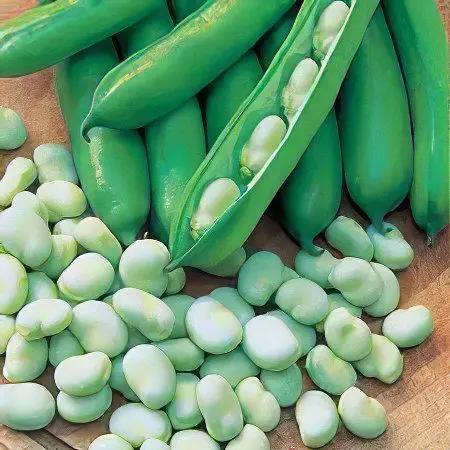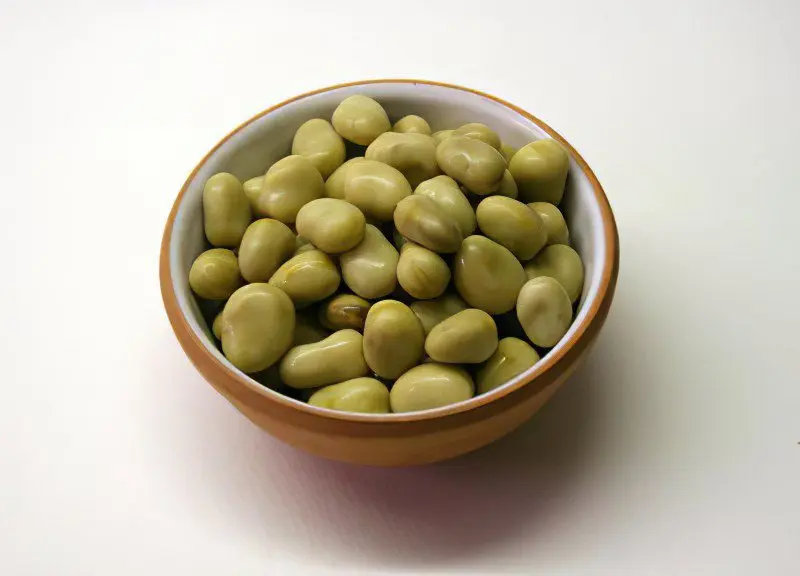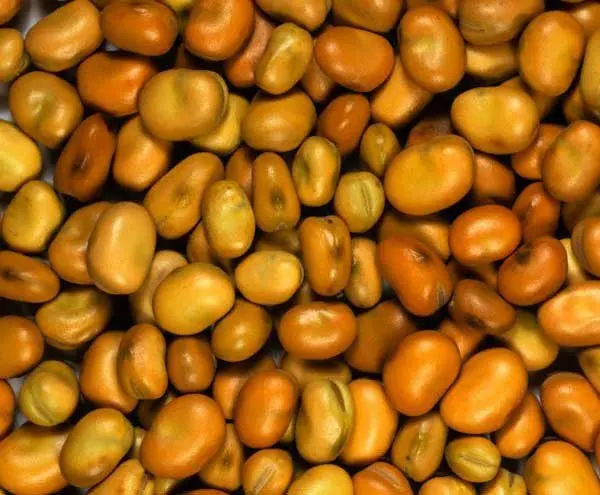Contents

Beans are an annual herbaceous plant with a well-developed root system and a hollow tetrahedral stem branching at the base. It reaches a height of 20–180 cm, the roots penetrate the soil up to 1,5 meters or more. The leaves are compound, paired and unpaired, pointed at the ends. The flowers are white, moth-like, large, bisexual, collected in short racemes of 5-6 pieces. The flowers contain a lot of nectar, so during the flowering period, the beans are often visited by butterflies and bumblebees.
The fruits are beans 4–30 cm long with two to five large seeds. Seeds of irregular shape, flat, can be white, purple, green, black, yellow. Beans are very photophilous and grow well in regions with long daylight hours. They can grow on almost any soil, excluding strongly acidic soils, regardless of weather conditions. The plant well enriches the soil with organic nitrogen. It does not grow wild in nature.
Composition and calorie content
Calories 341 KKal
- Fats:
1,5 g
- Proteins:
22,8 g
- Carbohydrates:
61,6 g
- Water:
11,0 g
- Ash:
3,1 g
- Cellulose:
25,0 g
Vitamins | Quantity | % RDN |
Vitamin B9 (folic acid) | 423 mcg | 106% |
Vitamin B1 (thiamine) | 0,56 mg | 33% |
Vitamin B5 (pantothenic acid) | 0,98 mg | 20% |
Vitamin B4 (choline) | 95,8 mg | 19% |
Vitamin B6 (pyridoxine) | 0,37 mg | 19% |
Vitamin B2 (riboflavin) | 0,33 mg | 17% |
Vitamin K | 6,0-18,1 μg | 10% |
Minerals (in 100 g): | Quantity | %RDN |
Cobalt | 33,5 mcg | 335% |
Nickel | 103-777 μg | 293% |
Vanadium | 88,4 mcg | 221% |
Bor | 153,4 mcg | 219% |
Molybdenum | 139,2 mcg | 199% |
Manganese | 1630-2000 μg | 91% |
Silicon | 24 mg | 80% |
Copper | 470-820 μg | 65% |
potassium | 1062-1690 mg | 55% |
Phosphorus | 365-489 mg | 54% |
Magnesium | 166-218 mg | 48% |
Hardware | 3,8-6,8 mg | 35% |
Chrome | 3,7-21,2 μg | 25% |
Zinc | 2780-3140 μg | 25% |
Zirconium | 11,2 mcg | 22% |
Iodine | 32,7 mcg | 22% |
Sulfur | 91,9-305,4 mg | 20% |
Titanium | 150 mcg | 18% |
Rubidium | 16,3 mcg | 16% |
Lead | 1,5 mcg | 15% |
* Strontium | 117,9 mcg | 15% |
Selenium | 8,2-8,8 μg | 13% |
Calcium | 64-205 mg | 12% |
Full chemical composition ➤
Other important connections:
Phytosterols — 124 mg (222,5% of RDI)
Purine — 92 mg (73,3% of RDI)
Oxalic acid — 27 mg (6,8% of RDI)
Useful properties of beans
Beans have been known to mankind since prehistoric times. In ancient Egypt, it was a sacred plant. In Palestine, they were grown as early as 1000 BC. In Rus’, they were an emergency reserve in case of war or natural disasters. Beans are suitable for use in stew, boiled, fried and canned. First and second courses are prepared from them, they are served with spices, meat, and vegetables.
Beans are the best source of vegetable protein (up to 40%), which perfectly replaces meat. They also contain a large amount of dietary fiber, which helps cleanse and normalize the bowels. The systematic use of beans reduces the level of cholesterol in the blood and makes the hair thick and shiny. Bean flour mixed with wheat or rye improves the taste of muffins and bread.
However, the plant is used not only for food, but also for medicinal purposes. Harvesting of raw materials is carried out in May, picking flowers and fruits as they ripen.
The use of beans in traditional medicine

The therapeutic effect of beans is recognized both by official and traditional medicine. Often, doctors recommend the use of beans for dystrophy, diabetes (molybdenum contained in the seeds of the plant reduces blood sugar), and obesity. They are prescribed for diseases of the kidneys and liver, hard physical and mental work.
They have a diuretic, astringent and anti-inflammatory effect, so healers prescribe boiled and mashed beans for inflammation of the gastrointestinal tract, accompanied by loosening of the stool.
Externally, the plant is used for skin diseases, boils and abscesses. Beans are also able to cleanse the body of toxins and salts of heavy metals, which is very important for residents of environmentally unfavorable regions. Beans are also used for preventive purposes.
Decoction of seeds: 2 tbsp. spoons of beans should be poured with two glasses of boiled water and boiled in a water bath for 10 minutes. After the broth has cooled, it should be divided into equal portions and drunk for 4 times.
Flower infusion: 2 tbsp. spoons of dry raw materials must be poured into 0,5 liters of boiling water, insist 2 hours and strain. Infusion is recommended to use for washing.
Black Russian beans
One of the oldest zoned varieties. In favorable conditions, it branches strongly, reaching a height of up to 110 cm. From 6 to 16 beans are formed on a strong stem, each of them up to 7–8 cm long. The bean is slightly curved, wrinkled, with two or three seeds of an elongated oval shape, flat, dark purple, almost black. The bean does not have a pigment layer and can be used for stewing and whole canning. The plant is widely distributed in the Leningrad region and in a wide strip to Transbaikalia.
fava beans

The roots of this plant penetrate deep into the ground, the root system is well developed. The stem is erect, tetrahedral, reaches a height of 0,7–2,0 m. The leaves are large, fleshy, paired, bluish-green. Flowers in racemes from two to 10 pieces. The flowers have a double five-membered perianth, one pistil with an upper ovary, and ten stamens. Seeds begin to germinate already at 3-5 degrees. The plant is moisture-loving.
In folk medicine, it is used as an anti-inflammatory and astringent. For external use, beans are best boiled in milk. Pounded into gruel, they accelerate the maturation of boils and abscesses, cleanse the skin of vitiligo. Beans are good for diabetes.
Decoction of seeds: 5-10 bean seeds are recommended to be roasted, finely ground and brewed as you usually brew coffee. Dosage – one coffee cup after a meal. A decoction is used for uterine fibroids.
Mung bean
Mung bean, or mung bean, is a unique leguminous crop characterized by small, oval beans with a green skin. India is considered the birthplace of this plant. To date, mung beans are actively cultivated in Thailand, China and Indonesia. Harvesting takes place twice a year – in June and November. Mash is highly valued for its dietary properties and excellent nutritional components. The composition of mung beans includes various minerals and vitamins, thanks to which mung bean can be called an excellent product with antiseptic and diuretic properties. Often it was mung beans that were used to detoxify the body. Since this product is rich in fiber and does not contain cholesterol, it is indispensable for diabetic patients. In addition, mung beans will help prevent the extensive development of cancerous tumors, and they can also normalize hormonal levels in many women during menopause.
The sprouts of such wonderful beans are rich in essential vitamins A, B, C, E, and are also an excellent source of minerals – iron, calcium and potassium.
Mung beans are characterized by an antitoxic effect. They perfectly heal thermal burns, remove toxins and harmful substances from the body, have a diuretic and hypolipidemic effect. In addition to iron and calcium, a large amount of ascorbic acid was found in germinated seeds.
Application of mung beans
These unusual beans are the perfect food for those who are trying to lose weight. Moreover, they are considered an excellent meat replacement product. Low fat content and a large amount of fiber and protein causes a decrease in the level of cholesterol in human blood. Mung beans have a beneficial effect on the treatment of such ailments as infectious and inflammatory diseases, which include bronchitis, tracheitis, rhinitis, sinusitis and laryngitis.
Due to the significant content of fibers, mung bean effectively normalizes the digestive system. Eating mung beans quickly prevents a rapid rise in blood sugar levels. Such a product can be prescribed for serious food poisoning. To get rid of acne, you can use gruel from mung bean. Along with this, such a healing gruel can be applied for small wounds and some skin dermatitis. It should be noted that modern cosmetics, which include mung beans, have appeared on sale.
Such an excellent product as mung beans is not recommended for individual intolerance, as well as for insufficient intestinal motility. When consumed in excess, mung beans can cause indigestion or flatulence.
Противопоказания
Despite the fact that beans are a very valuable product, and they have contraindications for consumption. Plant seeds can not be used as food for gout, oxaluria, glomerulonephritis. This is due to the fact that purines are present in beans. Also, beans are forbidden to be consumed raw, since they contain poisons: phaseolunothin glycoside and toxic albumin, which are destroyed only during heat treatment. It is not recommended to use beans for patients with colic associated with inflammation of the large intestine.









